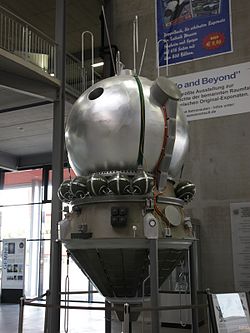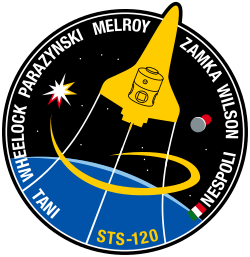STS-120
| STS-120 | |||||
 | |||||
| Uppdrag | 120 | ||||
|---|---|---|---|---|---|
| Rymdfärja | Discovery (34) | ||||
| NSSDC-ID | 2007-050A[1] | ||||
| Färdens tid | 15 dagar, 2 timmar, 23 minuter, 54 minuter | ||||
| Uppskjutning | |||||
| Startplats | Startplatta 39A vid Kennedy Space Center i Florida | ||||
| Start | 23 oktober 2007, 11:38:19 a.m. EDT, 17:38:19 CET | ||||
| Landning | |||||
| Landningsplats | Kennedy Space Center i Florida | ||||
| Landning | 7 november 2007, 1:01:17 p.m. EST, 19:01:17 CET | ||||
| Omloppsbana | |||||
| Varv | 238 st[2] | ||||
| Apogeum | 227 km | ||||
| Perigeum | 195 km | ||||
| Banlutning | 51,6° | ||||
| Sträcka | 10,0 miljoner km | ||||
| Rymdpromenad | |||||
| Antal | 4 st | ||||
| Total tid | 27 timmar, 14 minuter | ||||
| Dockning | |||||
| Rymdstation | ISS | ||||
| Dockning | 25 oktober 2007, 12:40 UTC | ||||
| Dockningsport | PMA-2 (Destiny, fram) | ||||
| Urdockning | 5 november 2007, 10:32 UTC | ||||
| Tid dockad | 10 dagar, 21 timmar, 52 minuter | ||||
| Besättning | |||||
| Befälhavare | Pamela Melroy (3) | ||||
| Pilot | George D. Zamka (1) | ||||
| Uppdragsspecialister | Stephanie D. Wilson (2) Scott E. Parazynski (5) Douglas H. Wheelock (1) Paolo A. Nespoli (1) ESA | ||||
 | |||||
| Kronologi Rymdfärjeprogrammet | |||||
| |||||
STS-120 var en rymdfärd till den internationella rymdstationen, ISS, som genomfördes av den amerikanska rymdfärjan Discovery mellan den 23 oktober och 7 november 2007.
Pamela Melroy var den andra kvinnan som var befälhavare på uppdrag med rymdskytteln. Den första var Eileen Collins i juli 2005 på STS-114. Samtidigt som detta uppdrag pågick kom Peggy Whitson att vara befälhavare för ISS Expedition 16, vilket innebär att detta var första gången som två kvinnliga befälhavare var i rymden samtidigt.
Last

STS-120 hade som mål att leverera och installera modulen Harmony (tidigare känd som Node-2), samt flytta solpanelen P6 till sin permanenta plats bredvid P5 truss.
Harmony är en amerikansk förbindelsemodul, byggd i Italien, som kom att förbinda det amerikanska laboratoriet med de kommande europeiska och japanska laboratorierna. STS-120 installerade temporärt Harmony på Unitys babord sida. Efter att STS-120 lämnat ISS flyttade expedition 16 med hjälp av Canadarm2 modulen till sin permanenta placering framför det amerikanska laboratoriet Destiny. Installationen av Harmony innebär att rymdstationens besättning kan utökas från tre till sex personer.
Flyttningen av solpanelen P6 förbereddes av de tre föregående uppdragen, STS-116, STS-117 och STS-118. Bland annat gjorde Christer Fuglesang tillsammans Robert Curbeam en extra rymdpromenad under STS-116 för att veckla ihop en krånglande solpanel på P6.
Aktiviteter
Innan uppskjutning
Uppdraget innan STS-120 var STS-118. STS-119 är flyttad ut ur nummerföljd och genomfördes under år 2009. Även STS-121 är flyttad ut ur nummerföljd och flögs i juli 2006.
Fastbränsleraketerna blev den 14 augusti sammankopplade med den externa tanken i Vehicle Assembly Building på Kennedy Space Center i Florida. Discovery rullade ut på startplatta 39-A den 30 september, 2007 för uppdraget.
Några timmar före uppskjutningen såg det ut som att en is bit på den externa bränsletanken skulle stoppa uppskjutningen.
Uppskjutningen

Rymdfärjan Discovery sköts upp 11:38:19 a.m. EDT.[3][4] Under nedräkningens sista minuter kunde en bit is som mätte 10 gånger 1 cm ses på kopplingen mellan rymdfärjan och den externa tanken. Nasas flygkontrollanter bedömde att biten var alltför liten för att utgöra något hot mot värmeskydden och uppskjutningen fortsatte som planerat.[5]
Besättning
 USA Pamela Melroy, befälhavare. (3).
USA Pamela Melroy, befälhavare. (3). USA George D. Zamka, pilot. (1).
USA George D. Zamka, pilot. (1). USA Stephanie D. Wilson, uppdragsspecialist. (2).
USA Stephanie D. Wilson, uppdragsspecialist. (2). USA Scott E. Parazynski, uppdragsspecialist. (5).
USA Scott E. Parazynski, uppdragsspecialist. (5). USA Douglas H. Wheelock, uppdragsspecialist. (1).
USA Douglas H. Wheelock, uppdragsspecialist. (1). Italien Paolo A. Nespoli, (ESA), uppdragsspecialist. (1).
Italien Paolo A. Nespoli, (ESA), uppdragsspecialist. (1).
Besättning på ISS som byts med detta uppdrag
 USA Daniel M. Tani, uppdragsspecialist. Reser med Discovery för att ingå i expedition 16 på ISS. (2).
USA Daniel M. Tani, uppdragsspecialist. Reser med Discovery för att ingå i expedition 16 på ISS. (2). USA Clayton Anderson, uppdragsspecialist. Återvänder till jorden från expedition 16.
USA Clayton Anderson, uppdragsspecialist. Återvänder till jorden från expedition 16.
Väckningar
Under Geminiprogrammet började NASA spela musik för besättningar och sedan Apollo 15 har man varje "morgon" väckt besättningen med ett särskilt musikstycke, särskilt utvalt antingen för en enskild astronaut eller för de förhållanden som råder.
| Dag | Låt | Artist/Kompositör | Spelad för | Länk |
|---|---|---|---|---|
| 2 | Lord of the Dance, | John Langstaff | Pam Melroy | WAV MP3 |
| 3 | Dancing in the Moonlight | King Harvest | Daniel Tani | WAV MP3 |
| 4 | Rocket Man | Elton John | Doug Wheelock | WAV MP3 |
| 5 | Bellissime Stelle (Italian for "Beautiful Stars") | Andrea Bocelli | Paolo Nespoli | WAV MP3 |
| 6 | What a Wonderful World | Louis Armstrong | Scott Parazynski | WAV MP3 |
| 7 | One By One | Wynton Marsalis | Stephanie Wilson | WAV MP3 |
| 8 | Malagueña Salerosa | Chingon | George Zamka | WAV MP3 |
| 9 | Nel Blu Dipinto di Blu (Volare) | Domenico Modugno | Nespoli | WAV MP3 |
| 10 | The Lion Sleeps Tonight | Robert John | hela besättningen | WAV MP3 |
| 11 | World | Five for Fighting | Wheelock | WAV MP3 |
| 12 | Star Wars Theme | John Williams | Parazynski | WAV MP3 |
| 13 | The Presence of the Lord | skriven av Kurt Carr, spelad av Byron Cage | Wilson | WAV MP3 |
| 14 | Roll Me Away | Bob Seger | Zamka | WAV MP3 |
| 15 | Space Truckin' | Deep Purple | Clayton Anderson | WAV MP3 |
| 16 | Chitty Chitty Bang Bang | Sherman Brothers | Pam | WAV MP3 |
Se även
Referenser
- ^ ”NASA Space Science Data Coordinated Archive” (på engelska). NASA. https://nssdc.gsfc.nasa.gov/nmc/spacecraft/display.action?id=2007-050A. Läst 22 mars 2020.
- ^ Manned Astronautics - Figures & Facts Arkiverad 16 augusti 2016 hämtat från the Wayback Machine., läst 28 juli 2016.
- ^ ”STS-120 MCC Status Report #01”. NASA. Arkiverad från originalet den 28 oktober 2007. https://web.archive.org/web/20071028131000/http://www.nasa.gov/mission_pages/shuttle/shuttlemissions/sts120/news/STS-120-01.html. Läst 24 oktober 2007.
- ^ ”Space Shuttle Discovery lifts”. Los Angeles Times. Arkiverad från originalet den 17 juni 2007. https://archive.is/20070617001238/http://www.latimes.com/news/science/la-sci-shuttle24oct24,0,6920516.story?coll=la-home-center.
- ^ ”Discovery launches after eventful countdown”. http://www.nasaspaceflight.com/content/?cid=5261. Läst 23 oktober, 2007.
Externa länkar
 Wikimedia Commons har media som rör STS-120.
Wikimedia Commons har media som rör STS-120.- NASAs sida om STS-120
- Svensk sida om STS-120
- ESA's sida om Node 2/Harmony
| ||||||||
| |||||||||||||||||||||||||||||||
| ||||||||||||||||||||||||||||||||
Media som används på denna webbplats
Rotated and color enhanced version of original (ISS013-E-48788 (6 July 2006) --- The Space Shuttle Discovery approaches the International Space Station for docking but before the link-up occurred, the orbiter went through a series of inspection photos by station crew to inspect the vehicle for any damage to its Thermal Protection System. This was known as the Rendezvous Pitch Maneuver and was implemented after the Columbia Disaster in 2003. The Leonardo Multipurpose Logistics Module can be seen in the shuttle's cargo bay. Discovery docked at the station's Pressurized Mating Adapter 2 at 9:52 a.m. CDT, July 6, 2006.)
Backdropped by a blue and white Earth, this close-up view features the Soyuz TMA-6 spacecraft approaching the International Space Station (ISS). Onboard the spacecraft are cosmonaut Sergei K. Krikalev, Expedition 11 commander representing Russia's Federal Space Agency; astronaut John L. Phillips, NASA ISS science officer and flight engineer; and European Space Agency (ESA) astronaut Roberto Vittori of Italy. The Soyuz linked to the Pirs Docking Compartment at 9:20 p.m. (CDT) on April 16, 2005 as the two spacecraft flew over eastern Asia. The docking followed Friday’s launch from the Baikonur Cosmodrome in Kazakhstan.
In this illustration, a SpaceX Crew Dragon spacecraft approaches the International Space Station for docking. NASA is partnering with Boeing and SpaceX to build a new generation of human-rated spacecraft capable of taking astronauts to the station and expanding research opportunities in orbit. SpaceX's upcoming Demo-1 flight test is part of NASA’s Commercial Crew Transportation Capability contract with the goal of returning human spaceflight launch capabilities to the United States.
Författare/Upphovsman: Pascal (Flickr user: pasukaru76), Licens: CC0
Vostok spacecraft replica at the Technik Museum Speyer, Germany.
STS118-S-001 (May 2007) --- The STS-118 patch represents Space Shuttle Endeavour on its mission to help complete the assembly of the International Space Station (ISS), and symbolizes the pursuit of knowledge through space exploration. The flight will accomplish its ISS 13A.1 assembly tasks through a series of spacewalks, robotic operations, logistics transfers, and the exchange of one of the three long-duration expedition crew members. On the patch, the top of the gold astronaut symbol overlays the starboard S-5 truss segment, highlighting its installation during the mission. The flame of knowledge represents the importance of education, and honors teachers and students everywhere. The seven white stars and the red maple leaf signify the American and Canadian crew members, respectively, flying aboard Endeavour.
KENNEDY SPACE CENTER, FLA. -- Against a cloud-filled sky, space shuttle Discovery roars toward space, leaving billows of smoke and steam behind on Launch Pad 39A at NASA's Kennedy Space Center. Liftoff was on time at 11:38:19 a.m. EDT. Discovery carries the Italian-built U.S. Node 2, called Harmony. During the 14-day STS-120 mission, the crew will install Harmony and move the P6 solar arrays to their permanent position and deploy them. Discovery is expected to complete its mission and return home at 4:47 a.m. EST on Nov. 6.
The STS-122 patch depicts the continuation of the voyages of the early explorers to today's frontier, space. The ship denotes the travels of the early expeditions from the east to the west. The space shuttle shows the continuation of that journey along the orbital path from west to east. A little more than 500 years after Columbus sailed to the new world, the STS-122 crew will bring the European laboratory module "Columbus" to the International Space Station to usher in a new era of scientific discovery.
Node 2 and Japanese Experimental Module (JEM) In Space Station Processing Facility
The STS-120 patch reflects the role of the mission in the future of the space program. The shuttle payload bay carries Node 2, the doorway to the future international laboratory elements on the International Space Station. On the left the star represents the International Space Station; the red colored points represent the current location of the P6 solar array, furled and awaiting relocation when the crew arrives. During the mission, the crew will move P6 to its final home at the end of the port truss. The gold points represent the P6 solar array in its new location, unfurled and producing power for science and life support. On the right, the moon and Mars can be seen representing the future of NASA. The constellation Orion rises in the background, symbolizing NASA's new exploration vehicle. Through all, the shuttle rises up and away, leading the way to the future.
STS-120 crew portrait (16 Feb. 2007)
These seven astronauts take a break from training to pose for the STS-120 crew portrait. Pictured from the left are astronauts Scott E. Parazynski, Douglas H. Wheelock, Stephanie D. Wilson, all mission specialists; George D. Zamka, pilot; Pamela A. Melroy, commander; Daniel M. Tani, Expedition 15 flight engineer; and Paolo A. Nespoli, mission specialist representing the European Space Agency (ESA). The crewmembers are attired in training versions of their shuttle launch and entry suits. Tani is scheduled to join Expedition 15 as flight engineer after launching to the International Space Station on mission STS-120 and is scheduled to return home on mission STS-122.











